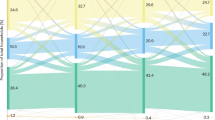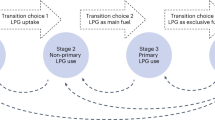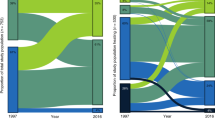Abstract
Rural household energy use for cooking and heating is an important source of air pollutants in China, as it affects both human health and climate change. However, the magnitude of rural household energy use, especially during the recent rapid socioeconomic transition period, has not been well quantified. Here, we present first-hand nationwide data from a 34,489-household energy-mix survey and a 1,670-household fuel-weighing campaign. We found that the consumption of wood and crop residues in rural China decreased by 63% and 51%, respectively, from 1992 to 2012, and these decreases were much greater than the 15% and 8%, respectively, reported by the International Energy Agency and Food and Agriculture Organization. The rapid residential energy transition over these two decades was primarily driven by the rapid socioeconomic development. One important implication of this transition is the significant reduction in the emissions of major air pollutants, especially incomplete combustion products leading to significant impacts on health and climate.
This is a preview of subscription content, access via your institution
Access options
Access Nature and 54 other Nature Portfolio journals
Get Nature+, our best-value online-access subscription
$29.99 / 30 days
cancel any time
Subscribe to this journal
Receive 12 digital issues and online access to articles
$119.00 per year
only $9.92 per issue
Buy this article
- Purchase on Springer Link
- Instant access to full article PDF
Prices may be subject to local taxes which are calculated during checkout





Similar content being viewed by others
References
Shen, H. Z. et al. Global atmospheric emissions of polycyclic aromatic hydrocarbons from 1960 to 2008 and future predictions. Environ. Sci. Technol. 47, 6415–6424 (2013).
Wang, R. et al. Exposure to ambient black carbon derived from a new inventory and high resolution model. Proc. Natl Acad. Sci. USA 111, 2459–2463 (2014).
Huang, Y. et al. Quantification of global primary emissions of PM2.5, PM10, and TSP from combustion and industrial process sources. Environ. Sci. Technol. 48, 13834–13843 (2014).
Wang, R. et al. Estimation of global black carbon direct radiative forcing and its uncertainty constrained by observations. J. Geophys. Res. Atmos. 121, 5948–5971 (2016).
Lelieveld, J. et al. The contribution of outdoor air pollution sources to premature mortality on a global scale. Nature 525, 367–371 (2015).
Xie, Y. & Hu, J. W. An introduction to the China Family Panel Studies (CFPS). Chin. Social. Rev. 47, 3–29 (2014).
Qiu, H. G. et al. Renewable energy consumption in rural China: current situation and major driven factors. J. Beijing Inst. Technol. 17, 10–15 (2015).
Chen, Y. L. et al. Transition of household cookfuels in China from 2010 to 2012. Appl. Energ. 184, 800–809 (2016).
World Energy Statistics and Balances (International Energy Agency, Paris, 2016).
National Bureau of Statistics China Statistical Yearbook 2011 (China Statistics Press, Beijing, 2012).
China Statistical Yearbooks Database (National Bureau of Statistics, accessed August 2016); http://www.cnki.net/software/xzydq.html
Janssens-Maenhout, G. et al. HTAP_v2.2: a mosaic of regional and global emission grid maps for 2008 and 2010 to study hemispheric transport of air pollution. Atmos. Chem. Phys. 15, 11411–11432 (2015).
Emission Database for Global Atmospheric Research (EDGAR_v4.2) (European Commission, Joint Research Centre (JRC)/Netherlands Environmental Assessment Agency (PBL), accessed 20 December 2016); http://edgar.jrc.ec.europa.eu
Major Figures on 2010 Population Census of China SPCO, The Sixth Population Census Office of the State Council (China Statistical Press, Beijing, 2012).
Ministry of Environmental Protection Exposure Related Activity Patterns Research of Chinese Population, Adults (China Environment Press, Beijing, 2013).
Hu, J. Y. Difference in Direct Residential Energy Consumption between Urban and Rural Households. MSc Thesis, Northern China Electric Power Univ. (2012).
China unveils 2017–2021 winter clean heating plan. Reuters www.reuters.com/article/us-china-energy-heating/china-unveils-2017-2021-winter-clean-heating-plan-media-idUSKBN1EB02P (2017).
Heltberg, R. Fuel switching, evidence from eight developing countries. Energ. Econ. 26, 869–887 (2004).
Cai, J. & Jiang, Z. Changing of energy consumption patterns from rural households to urban households in China, an example from Shaanxi province, China. Renew. Sust. Energ. Rev. 12, 1667–1680 (2008).
Peng, W. Y., Hisham, Z. & Pan, J. H. Household level fuel switching in rural Hubei. Renew. Sust. Energ. Rev. 14, 238–244 (2010).
Sovacool, B. K. Conceptualizing urban household energy use, climbing the 'energy services ladder'. Energ. Policy 39, 1659–1668 (2011).
Chen, H. et al. Modeling temporal variations in global residential energy consumption and pollutant emissions. Appl. Energ. 20, 327–340 (2016).
Zhu, D. et al. Temporal and spatial trends of residential energy consumption and air pollutant emissions in China. Appl. Energ. 106, 17–24 (2013).
Zhang, S. S. & Lin, B. Q. Impact of tiered pricing system on China’s urban residential electricity consumption: survey evidences from 14 cities in Guangxi Province. J. Clean. Prod. 170, 1404–1412 (2018).
Zhu, C. Z. Should the domestic electricity price be reduced? China Power Ind. Manag. 11, 42–45 (2015).
FAOSTAT (FAO, accessed 18 December 2016); http://www.fao.org/faostat/en/#data
Jiang, X. Y., Sommer, S. G. & Christensen, K. V. A review of the biogas industry in China. Energ. Policy 39, 6073–6081 (2011).
Lu, M. et al. Rebound effects for residential electricity use in urban China: an aggregation analysis based E-I-O and scenario simulation. Ann. Oper. Res. 255, 525–546 (2017).
Wang, Z. W. et al. Measurement of energy rebound effect in households: evidence from residential electricity consumption in Beijing, China. Renew. Sust. Energ. Rev. 58, 852–861 (2016).
Zhong, Q. R. et al. Global estimates of carbon monoxide emissions from 1960 to 2013. Environ. Sci. Pollut. Res. 24, 864–873 (2017).
Shen, H. Z. et al. Global lung cancer risk from PAH exposure highly depends on emission sources and individual susceptibility. Sci. Rep. 4, 6561 (2014).
Chafe, Z. A. et al. Household cooking with solid fuels contributes to ambient PM2.5 air pollution and the burden of disease. Environ. Health Persp. 122, 1314–1320 (2015).
Zhang, W. M. China Rural Statistical Yearbook, 2015 (China Statistics Press, Beijing, 2015).
Ni, Y. J. Clean air action plan of this year will focus on rural coal use, high emission vehicles, and city fringe, Sina News 016, 1.4 (2016); http://news.sina.com.cn/c/2016-01-04/doc-ifxncyar6295849.shtml
Shen, G. F. et al. Reductions in emissions of carbonaceous particulate matter and polycyclic aromatic hydrocarbons from combustion of biomass pellets in comparison with raw fuel burning. Environ. Sci. Technol. 46, 6409–6416 (2012).
Chen, Y. C. et al. Household air pollution and personal exposure risk of polycyclic aromatic hydrocarbons among rural residents in Shanxi, China. Indoor Air 26, 246–258 (2016).
Zhang, Q. H. & Nur, A. Analysis of multidimensional poverty of farmers in the poverty-stricken ethnic minority regions: a case study of three regions of Southern Xinjiang. Res. Agric. Mod. 37, 270–276 (2016).
Guo, X. M. & Gao, J. Key relations in targeting poverty alleviation strategy. Tianfu Theory 4, 1–5 (2016).
Zhao, S. & Liu, S. H. Dilemma and approach to energy poverty in the construction of new village. J. South China Agric. Univ. 11, 14–22 (2012).
Tian, Y. S. Current and future development of rural energy in China. Energy China 35, 11–15 (2013).
Liu, C. X. et al. The diagnosis of health education on preventing indoor air pollution (IAP) in rural areas. J. Prev. Med. Inf. 20, 259–262 (2014).
The State Council. Notification on distributing the scheme for the Second National Census of Pollutant Sources (Office of the State Council, Beijing, 2017).
Social and Demographic Surveys (UN Department of Economic and Social Affairs, accessed 12 April 2018); https://unstats.un.org/unsd/demographic/sources/surveys/default.htm
Shen, G. F. et al. Comparison of carbonaceous particulate matter emission factors among different solid fuels burned in residential stoves. Atmos. Environ. 89, 337–345 (2014).
Chen, Z. J. Correlation of spatial distribution of college students with regional economy analysis—a case study of Gansu Province. Resource Development Market 30, 1185–1189 (2014).
Huang, Y. et al. Global organic carbon emissions from primary sources from 1960 to 2009. Atmos. Environ. 122, 505–512 (2015).
Su, S. S. et al. Sulfur dioxide emissions from combustion in China: from 1990 to 2007. Environ. Sci. Technol. 45, 8403–8410 (2011).
Ru, M. Y. et al. Direct energy consumption associated emissions by rural-to-urban migrants in Beijing. Environ. Sci. Technol. 49, 13708–13715 (2015).
Emission Inventories of Major Air Pollutants (Peking University, accessed 12 April 2018); http://inventory.pku.edu.cn
Acknowledgements
We sincerely thank all the professors and students who participated in the China rural energy survey. This study is supported by the National Natural Science Foundation of China (grant nos 41390240, 41571130010 and 41629101), the 111 Project (grant no. B14001), the undergraduate student research training program of the Ministry of Education and the United Nations Foundation (Clean Stove Alliance, grant no. PR-15-39806). Comments from K. Smith, T. Gasser and D. O. Carpenter are appreciated.
Author information
Authors and Affiliations
Contributions
S.T. designed the study. S.T., M.Y.R., G.F.S., H.Z.S., S.J.Z., Y.L.C., X.Y., X.L.W., W.X.L., H.F.C. and D.Q.Z. designed the questionnaire and organized the survey. W.D., T.B.H., N.L. and S.S. conducted the weighing campaign. Data analysis was conducted by S.T., M.Y.R., X.Z., Q.R.Z., B.G.L., J.F.L., W.J.M., X.L.P. and Y.X. Writing was led by S.T. with inputs from M.Y.R., W.D., X.Z., Q.R.Z. and B.G.L.
Corresponding author
Ethics declarations
Competing interests
The authors declare no competing interests.
Additional information
Publisher's note: Springer Nature remains neutral with regard to jurisdictional claims in published maps and institutional affiliations.
Electronic supplementary material
Supplementary Information
Supplementary Figures 1–11, Supplementary Tables 1–4, Supplementary References
Rights and permissions
About this article
Cite this article
Tao, S., Ru, M.Y., Du, W. et al. Quantifying the rural residential energy transition in China from 1992 to 2012 through a representative national survey. Nat Energy 3, 567–573 (2018). https://doi.org/10.1038/s41560-018-0158-4
Received:
Accepted:
Published:
Issue Date:
DOI: https://doi.org/10.1038/s41560-018-0158-4
This article is cited by
-
Dynamic disparities in clean energy use across rural–urban, regional, and ethnic boundaries in China
Ambio (2024)
-
An integrated view of correlated emissions of greenhouse gases and air pollutants in China
Carbon Balance and Management (2023)
-
Environmental sanitation and undernutrition among China’s children and adolescents from 1989 to 2011
Nature Water (2023)
-
Examining energy inequality under the rapid residential energy transition in China through household surveys
Nature Energy (2023)
-
Costs and health benefits of the rural energy transition to carbon neutrality in China
Nature Communications (2023)



